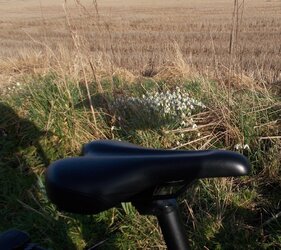biggs682
Itching to get back on my bike's
- Location
- Northamptonshire
First arrival on the bird table was Mrs Blackbird now enjoying a wash in the bird bath .
To further complicate matters, your first photo is an adult female, the second photo is a juvenile male (so after it has left the nest but before it has acquired adult plumage). The adult male looks like this:A final word from me on sexing Sparrow hawks...unless ive got it wrong again of course!Some bird guides say the male has a grey back and the female's brown.....this aint right and what led me to being confused.
What i know for sure is 1. the female is larger than the male 2. has greyish chest barring 3. Grey predominates
The male is smaller and has brownish chest barring and brown predominates.
Female
View attachment 629989
Male
View attachment 629995
Thanks nickyboy i think ive sussed it nowTo further complicate matters, your first photo is an adult female, the second photo is a juvenile male (so after it has left the nest but before it has acquired adult plumage). The adult male looks like this:
View attachment 630483
You can see in the photo of the juvenile it has the beginnings of the throat/cheek coloration that a female (either adult of juvenile) doesn't have
 very handsome birds
very handsome birds 

Snipe and Jack Snipe are similar. The best way to tell them apart is how they flush. Snipe will flush when you get a bit too close to them (like most birds). Jack Snipe will not flush until you almost stand on them. It sounds like yours were Snipe (which are considerably commoner than Jack Snipe too)I'm pretty sure I put up a few pairs of snipe while on my ride across the Mosses yesterday. I can't think what else they could've been, in this season and that environment. Lots of patches of snowdrops in full flower in various random places, too - even just at the field/road boundary through all the leek fields ... Here's just one of many such random snowdrop patches, this is on the edge of a non-leek field although there were non-stop leeks on the other side of the road. Not the usual sort of place you'd expect find snowdrops, no houses or woodland or parkland around, They're just ... flourishing all over the place. A good sign that there's not too much going on in the way of constant herbicides and the like I suppose? Maybe they enjoy the company of leeks, or something?
View attachment 630564
Yes, that's what I thought. I know they weren't woodcock, either - wrong sort of environment, much less common and the wrong sort of take-off flight.Snipe and Jack Snipe are similar. The best way to tell them apart is how they flush. Snipe will flush when you get a bit too close to them (like most birds). Jack Snipe will not flush until you almost stand on them. It sounds like yours were Snipe (which are considerably commoner than Jack Snipe too)

Sniff the scented tussock 😂😂😂Our most frequent badger visitor only has one good eye.
View attachment 630899
So I'm prepared to cut him/her some slack, poor thing. But now, he(?) seems to have claimed our garden as his territory.
Here s/he is scent marking, before drinking half the pond.
I've tried to persuade Mrs Poacher to sniff the scented tussock (@Fnaar) but she's strangely reluctant.
View attachment 630901
Our occasional visitor, fully sighted, has also done the scent marking thing. I'd guess they're from the same sett, but not sure.
Twice I've seen the fully sighted one poking its head through the hole that has been dug under our front fence, but been put off by the glow of the infra-red light. Since moving the trailcam to cover part of the garden, it's not so fearful.
View attachment 630904
Scent marking. Genuine thing - if it was a dog I'd de-worm it, but badgers use their sub-caudal gland to tell other badgers that they've been there. They also mark each other, which sounds like fun.
View attachment 630906
 Also heard skylarks, thrushes & a Blackcap. Saturday was woodpecker day though, heard about 3 tapping, so not sure what sort they were, but also heard several Green ones, as they're pretty distinctive. Loads of dozy pheasants, buzzards, a Red Kite & a Kestrel too
Also heard skylarks, thrushes & a Blackcap. Saturday was woodpecker day though, heard about 3 tapping, so not sure what sort they were, but also heard several Green ones, as they're pretty distinctive. Loads of dozy pheasants, buzzards, a Red Kite & a Kestrel too 
 as it's pulling loft insulation out of the roof and making a right mess, time to borrow my neighbour's ladder again & block up the hole with chicken wire, before it starts nesting properly. We did leave them one year, but my daughter's bedroom was infested with mites when they left the nest, that went down well
as it's pulling loft insulation out of the roof and making a right mess, time to borrow my neighbour's ladder again & block up the hole with chicken wire, before it starts nesting properly. We did leave them one year, but my daughter's bedroom was infested with mites when they left the nest, that went down well 
